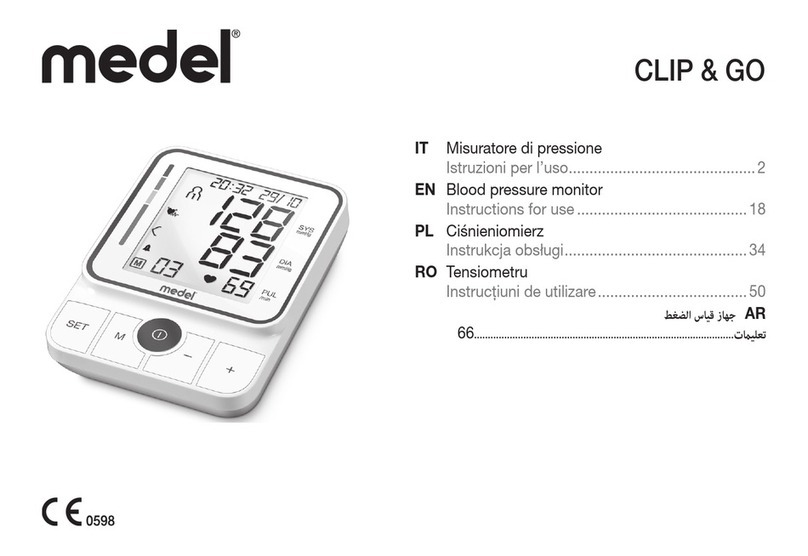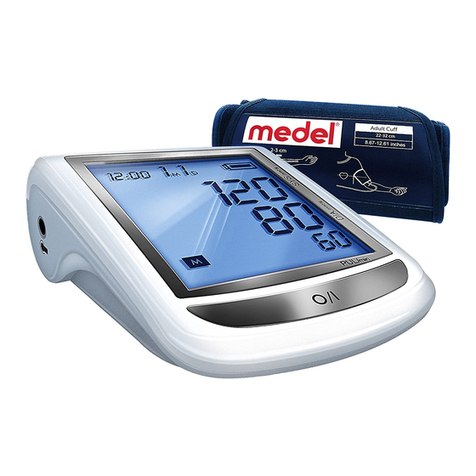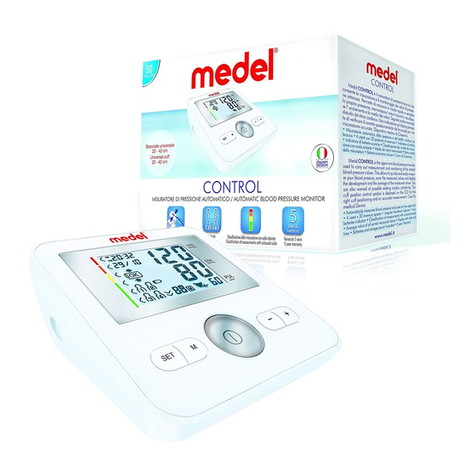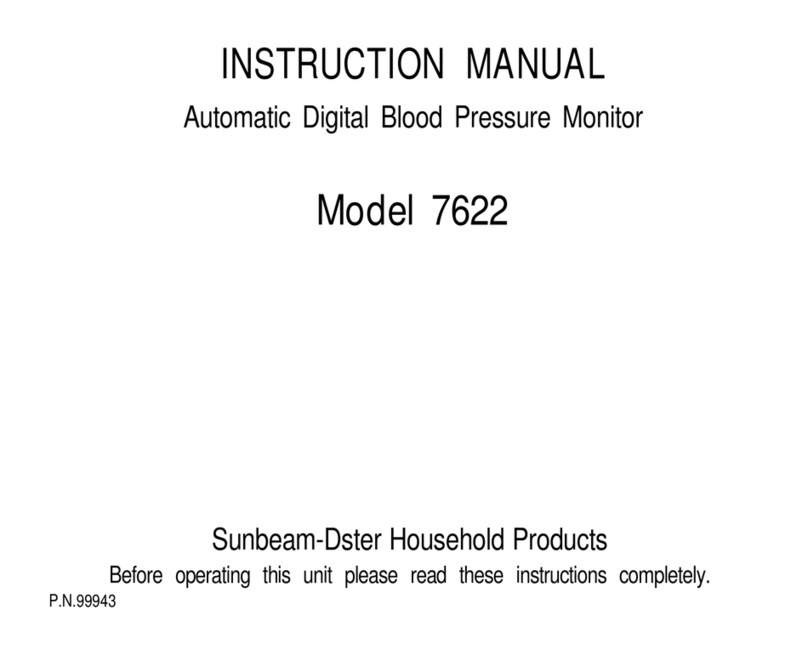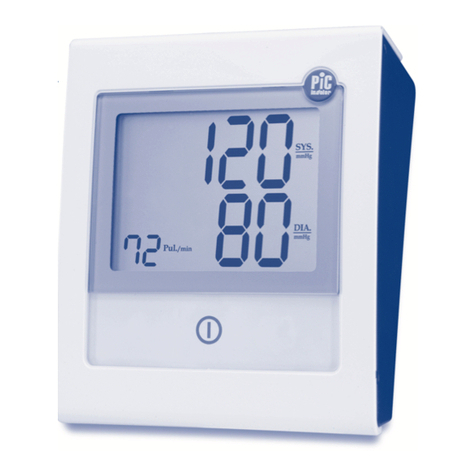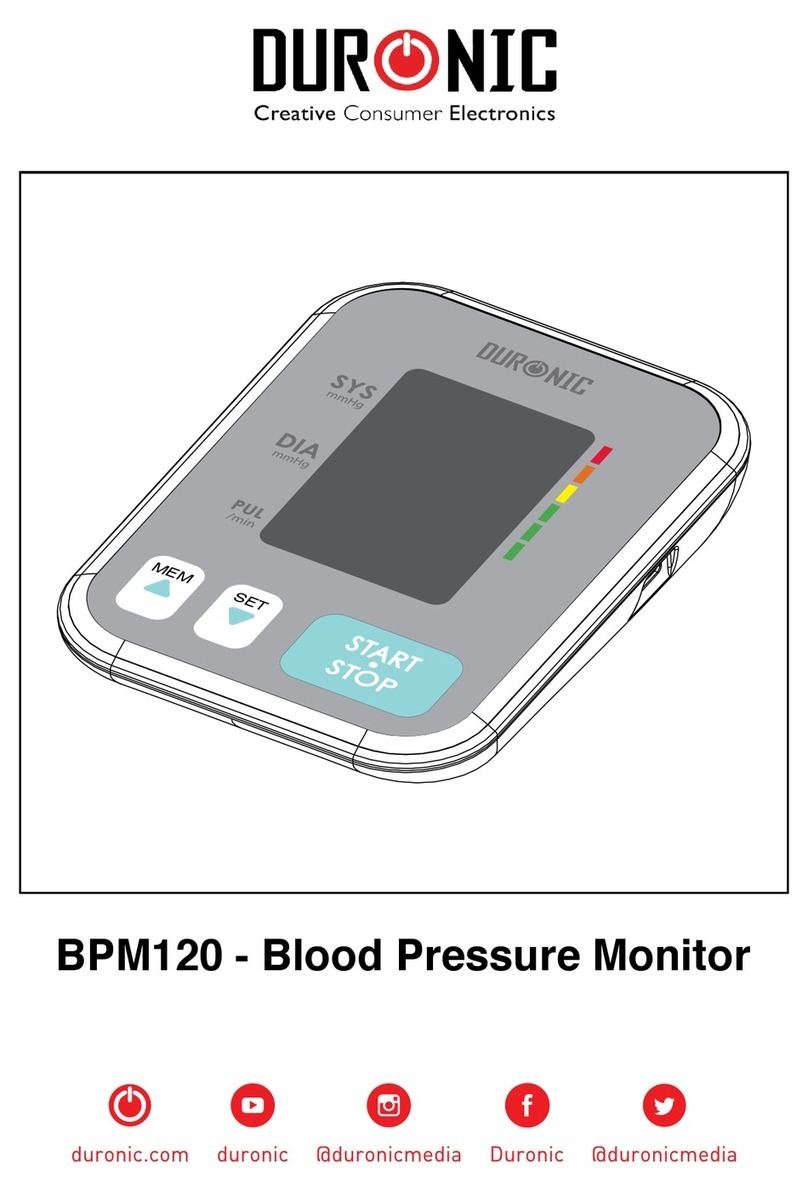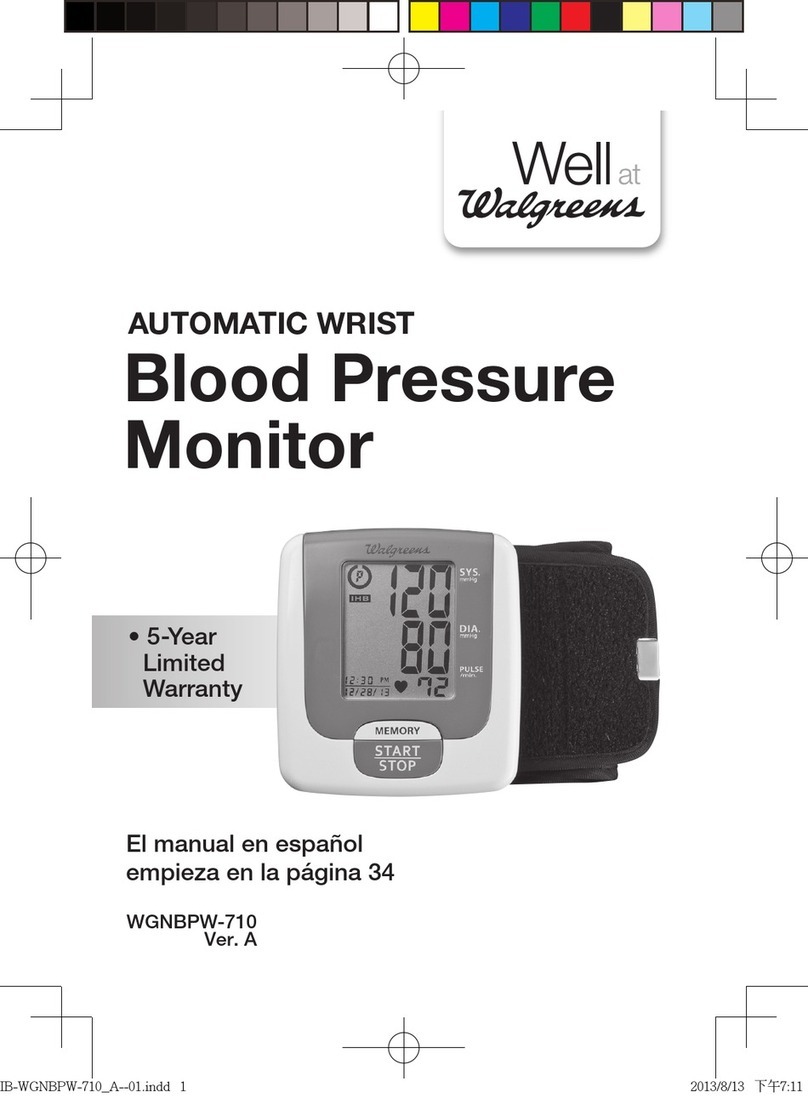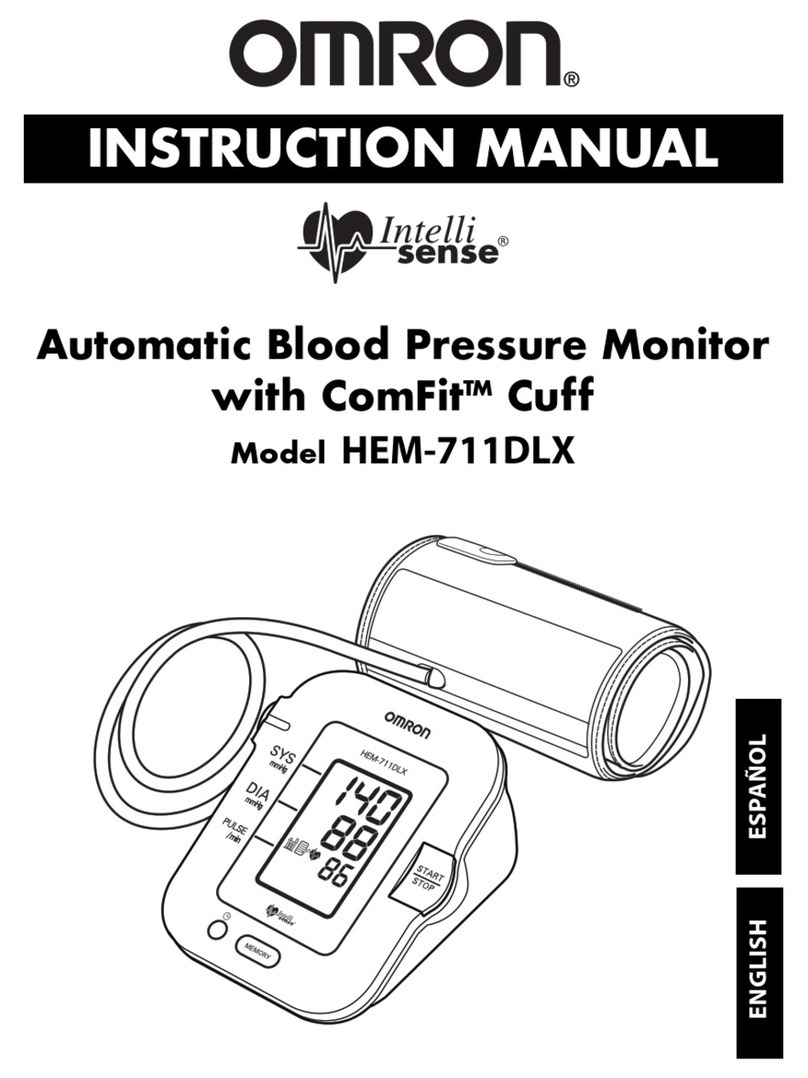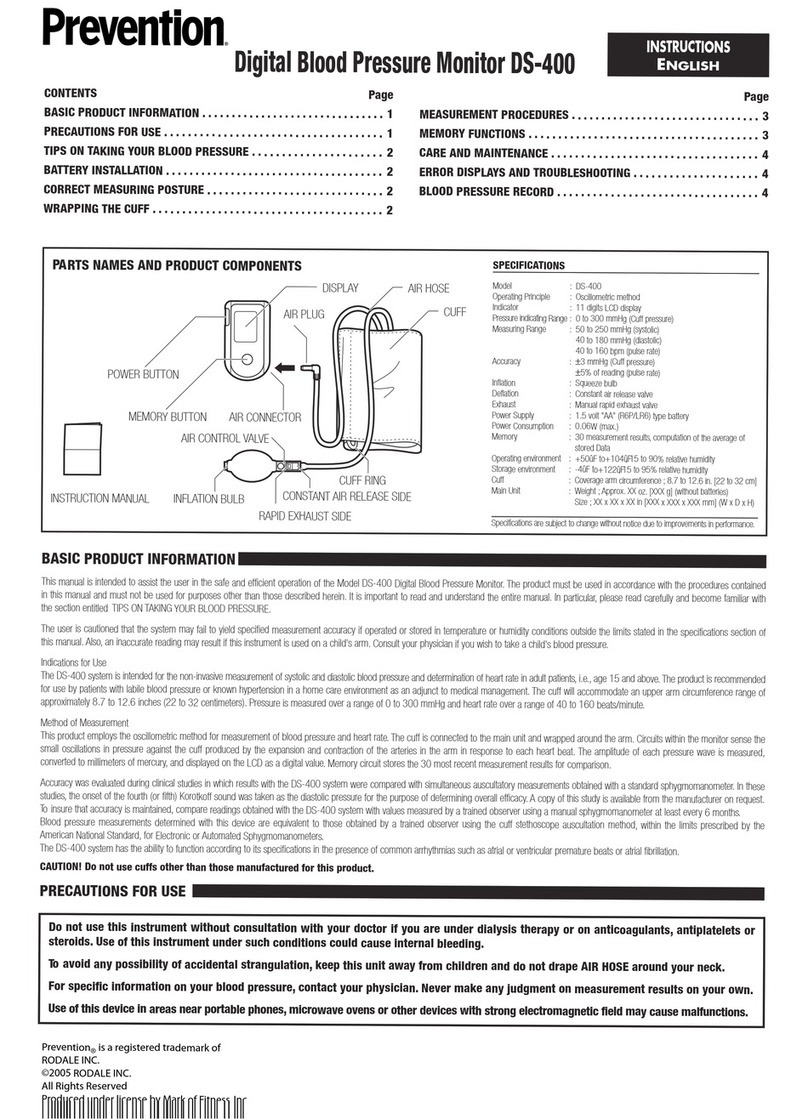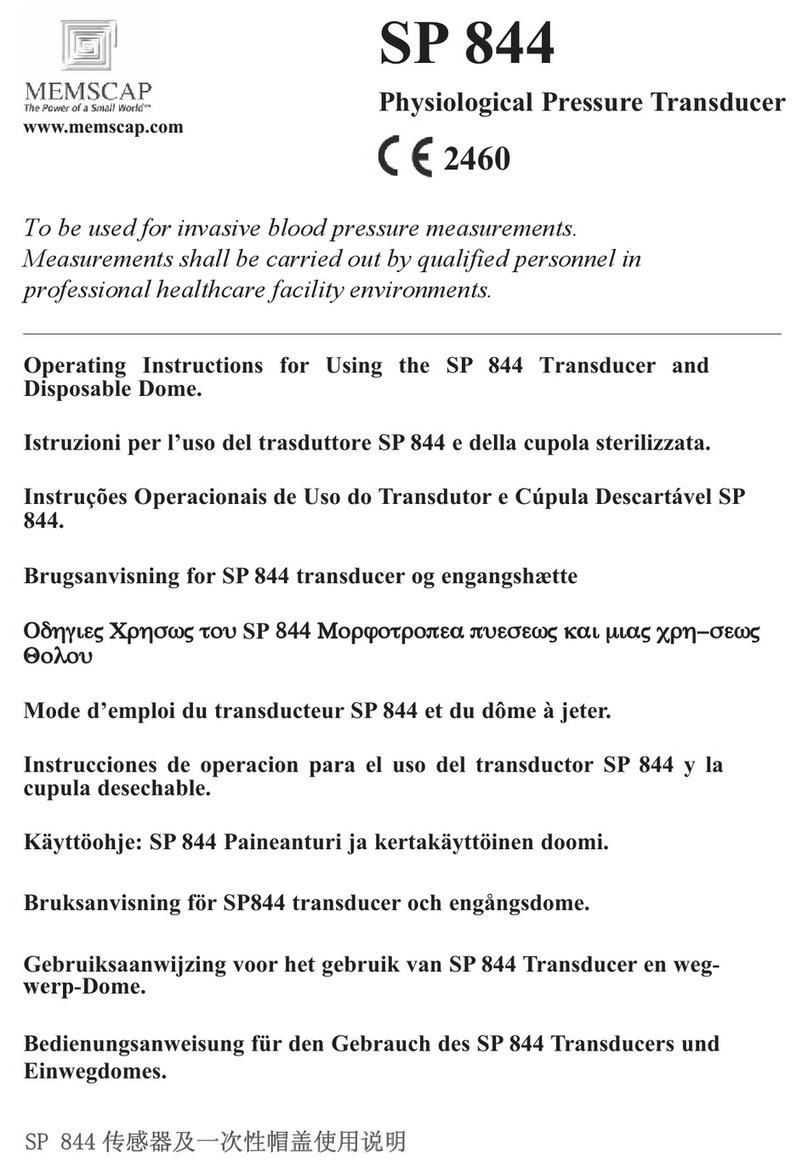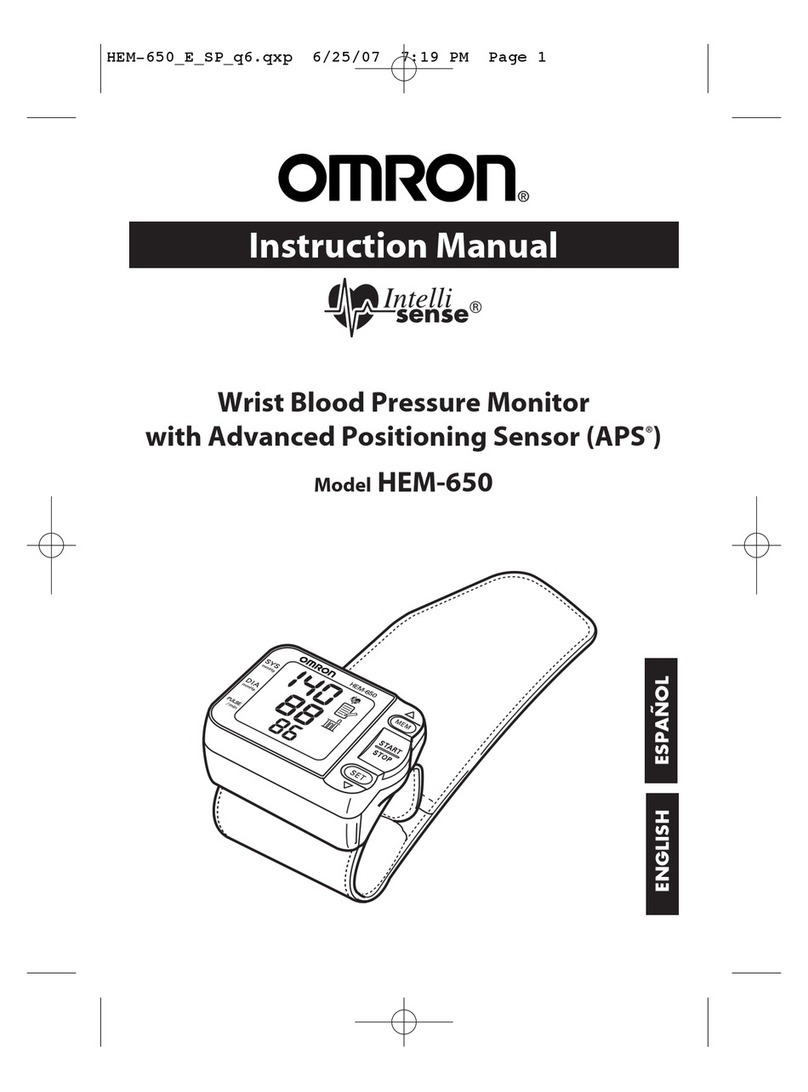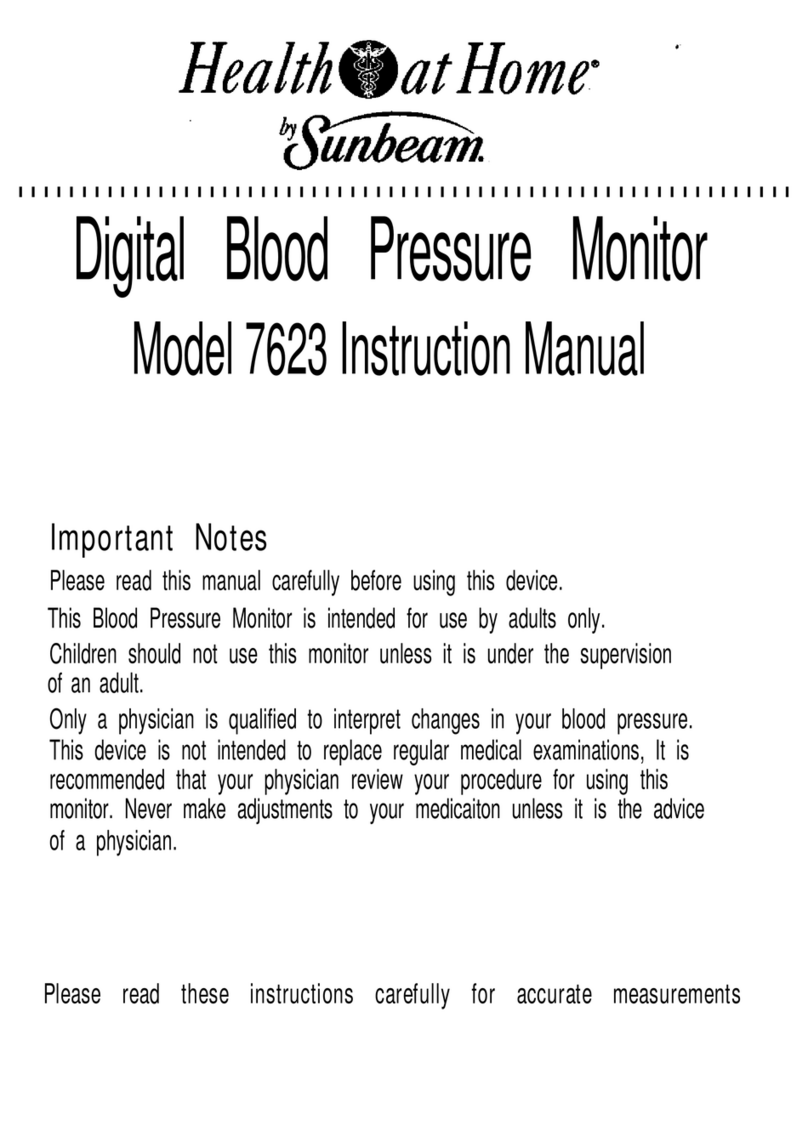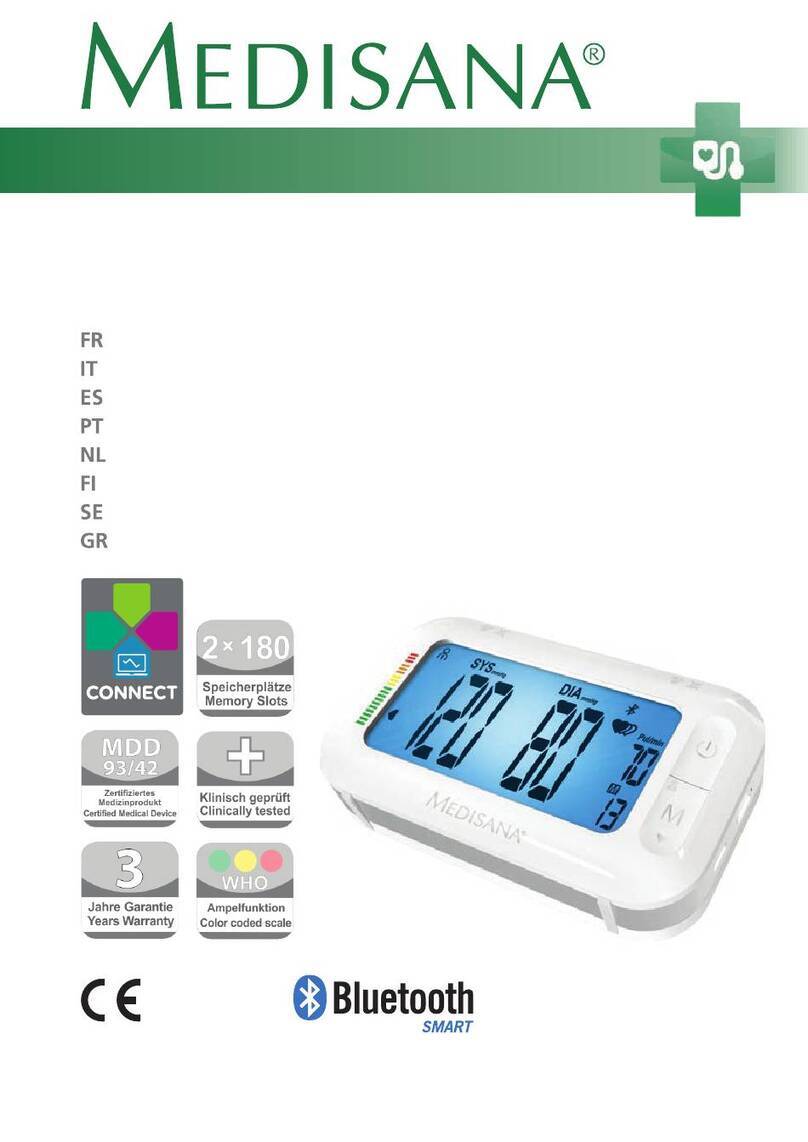Medel GCE602 User manual

MEDEL SENSE
TYPE GCE602
EN Blood pressure monitor
Instructions for use.................................................. 2

2
Included in delivery
•
Blood pressure monitor
•
Upper arm cuff
•
4 x 1.5 V LR6 AA batteries
•
Storage bag
•
Instructions for use
Dear customer,
Thank you for choosing one of our products. Our name
stands for high-quality, thoroughly tested products for appli-
cations in the areas of weight, blood pressure, body tempe-
rature, pulse, electrostimulation, beauty and air. Please read
these instructions for use carefully and keep them for later
use, be sure to make them accessible to other users and
observe the information they contain.
With kind regards,
Your Medel International team
1. Getting to know your device
Check that the device packaging has not been tampered
with and make sure that all contents are present. Before use,
ensure that there is no visible damage to the device or acces-
sories and that all packaging material has been removed. If
you have any doubts, do not use the device and contact your
retailer or the specified Customer Services address.
INTENDED USE
The Medel Sense automatic Blood Pressure Monitor is
indicated for home use for the non-invasive measurement
of diastolic and systolic blood pressures and pulse rate
ENGLISH
Contents
1. Getting to know your device ....................................... 18
2. Important notes ........................................................... 19
3. Device description ...................................................... 23
4. Preparing the measurement ........................................ 24
5. Measuring blood pressure .......................................... 25
6. Evaluating results ........................................................ 27
7. Saving, displaying and deleting measured values ...... 30
8. Error messages/troubleshooting ................................. 30
9. Cleaning and storing the device and cuff.................... 31
10. Technical specifications .............................................. 31
11. Mains adapter ............................................................. 32
12. Warranty /service ......................................................... 32

3
of adults by means of an inflatable cuff which is wrapped
around the upper arm.
INTENDED USER
Adult population with upper arm size 22-42cm.
The patient is the intended operator, except in case of pati-
ents that require special assistance.
2. Important notes
Signs and symbols
The following symbols are used in these instructions for
use, on the packaging and on the type plate for the device
and the accessories:
Attention
Note
Note on important information
Observe the instructions for use
Application part, type BF
Direct current
Disposal in accordance with the Waste
Electrical and Electronic Equipment EC
Directive – WEEE
21
PAP
Dispose of packaging in an environmen-
tally friendly manner
Manufacturer
Permissible storage and transport tem-
perature and humidity
Permissible operating temperature and
humidity
IP21
Protected against solid foreign objects
12.5 mm in diameter and larger, and
against vertically falling drops of water
S
N
Serial number : lot number / serial number
The CE labelling certifies that the pro-
duct complies with the essential require-
ments of Directive 93/42/EEC on medical
devices.
Authorised Representative in the Europe-
an Community.
EC REP
10°C
40°C
RH 15% - 85%
Operating
-20°C
55°C
RH 10% - 90%
Storage

4
Notes on use
•
In order to ensure comparable values, always measure
your blood pressure at the same time of day.
•
Do not take a measurement within 30 minutes of eating,
drinking, smoking or exercising.
•
Before the initial blood pressure measurement, make sure
always to rest for about 5 minutes.
•
Furthermore, if you want to take several measurements in
succession, make sure always to wait for at least 1 minute
between the individual measurements.
•
Repeat the measurement if you are unsure of the meas-
ured value.
•
The measured values taken by you are for your informa-
tion only – they are no substitute for a medical examina-
tion. Discuss the measured values with your doctor and
never base any medical decisions on them (e.g. medi-
cines and their administration).
•
Using the blood pressure monitor outside your home
environment or whilst on the move (e.g. whilst travelling
in a car, ambulance or helicopter, or whilst undertaking
physical activity such as playing sport) can influence the
measurement accuracy and cause incorrect measure-
ments.
•
Do not use the blood pressure monitor on newborns or
patients with pre-eclampsia. We recommend consulting
a doctor before using the blood pressure monitor during
pregnancy.
•
Cardiovascular diseases may lead to incorrect measure-
ments or have a detrimental effect on measurement accu-
racy. The same also applies to very low blood pressure,
diabetes, circulatory disorders and arrhythmias as well as
chills or shaking.
•
This device is not intended for use by people (including
children) with restricted physical, sensory or mental skills
or a lack of experience and/or a lack of knowledge, unless
they are supervised by a person who is responsible for
their safety or are instructed by such a person in how to
use the device. Supervise children around the device to
ensure they do not play with it.
•
The blood pressure monitor must not be used in connec-
tion with a high-frequency surgical unit.
•
Only use the device on people who have the specified
upper arm measurement for the device.
•
Please note that when inflating, the functions of the limb
in question may be impaired.
•
During the blood pressure measurement, the blood circu-
lation must not be stopped for an unnecessarily long time.
If the device malfunctions remove the cuff from the arm.

5
•
Avoid any mechanical restriction, compression or bending
of the cuff line.
•
Do not allow sustained pressure in the cuff or frequent
measurements. The resulting restriction of the blood flow
may cause injury.
•
Make sure that the cuff is not placed on an arm in which
the arteries or veins are undergoing medical treatment,
e.g. intravascular access or intravascular or therapy, or an
arteriovenous (AV) shunt.
•
Do not use the cuff on people who have undergone a
mastectomy.
•
Do not place the cuff over wounds as this may cause fur-
ther injury.
•
Place the cuff on your upper arm only. Do not place the
cuff on other parts of the body.
•
You can either use the blood pressure monitor with bat-
teries or with a mains adapter. For mains operation, the
device must be set up so that it can be disconnected by
the user at any time. As soon as the batteries are empty
or the mains adapter is disconnected from the power
supply, the blood pressure monitor loses the date and
time.
•
To conserve the batteries, the blood pressure monitor
switches off automatically if you do not press any buttons
for 30seconds.
•
The device is only intended for the purpose described in
these instructions for use. The manufacturer is not liable
for damage resulting from improper or careless use.
Instructions for storage and maintenance
•
The blood pressure monitor is made from precision and
electronic components. The accuracy of the measured
values and service life of the device depend on its careful
handling:
– Protect the device from impacts, humidity, dirt, marked
temperature fluctuations and direct sunlight.
– Do not drop the device.
– Do not use the device in the vicinity of strong electro-
magnetic fields and keep it away from radio systems or
mobile telephones.
– Only use the cuff included with the delivery or original
replacement parts. Otherwise incorrect measured values
will be recorded.
•
We recommend that the batteries be removed if the de-
vice will not be used for a prolonged period of time.
Notes on handling batteries
•
If your skin or eyes come into contact with battery fluid,
rinse the affected areas with water and seek medical
assistance.

6
•
Choking hazard! Small children may swallow and
choke on batteries. Store the batteries out of the reach of
small children.
•
Observe the plus (+) and minus (-) polarity signs.
•
If a battery has leaked, put on protective gloves and clean
the battery compartment with a dry cloth.
•
Protect batteries from excessive heat.
•
Risk of explosion! Never throw batteries into a fire.
•
Do not charge or short-circuit batteries.
•
If the device is not to be used for a relatively long period,
take the batteries out of the battery compartment.
•
Use identical or equivalent battery types only.
•
Always replace all batteries at the same time.
•
Do not use rechargeable batteries.
•
Do not disassemble, split or crush the batteries.
Instructions for repairs and disposal
•
Batteries do not belong in household waste. Please dis-
pose of empty batteries at the collection points intended
for this purpose.
•
Do not open the device. Failure to comply will result in
voiding of the warranty.
•
Do not repair or adjust the device yourself. Proper opera-
tion can no longer be guaranteed in this case.
•
Repairs must only be carried out by Customer Services
or authorised suppliers. Before making a claim, please
check the batteries first and replace them if necessary.
•
Please dispose of the device in accordance with EC
Directive – WEEE (Waste Electrical and Electronic
Equipment).
If you have any questions, please contact the local authori-
ties responsible for waste disposal.
Notes on electromagnetic compatibility
•
The device is suitable for use in all environments listed in
these instructions for use, including domestic environments.
•
The use of the device may be limited in the presence of
electromagnetic disturbances. This could result in issues
such as error messages or the failure of the display/device.
•
Avoid using this device directly next to other devices or
stacked on top of other devices, as this could lead to faulty
operation. If, however, it is necessary to use the device in
the manner stated, this device as well as the other devices
must be monitored to ensure they are working properly.
•
The use of accessories other than those specified or
provided by the manufacturer of this device can lead to
an increase in electromagnetic emissions or a decrease in
the device’s electromagnetic immunity; this can result in
faulty operation.
•
Failure to comply with the above can impair the perfor-
mance of the device.

3. Device description
1. Cuff
2. Cuff line
3. Cuff connector
4. Display
5. Connection for cuff connector
6. Risk indicator
7. Connection for mains adapter
8. Function buttons -/+
9. START/STOPbutton
10. Memory button M
11. Setting button SET
Information on the display:
1. Time and date
2. Systolic pressure
3. Diastolic pressure
4. Calculated pulse value
5. Cardiac arrhythmia
symbol pulse
symbol
6. Release air
7. Memory display:
average value ( ),
morning ( ),
evening ( ), memory
space number
8. Battery replacement symbol
9. Alarm function
10. Risk indicator
11. User memory
12. Cuff position control
13. Resting indicator display
1
2
1
2
91011
8
6
5
4
2
13
7
1
2
1
5678
2
3
4
9
11
10
13
12
7

4. Preparing the measurement
Inserting the batteries
•
Open the battery compartment lid.
•
Insert four 1.5V AA (alkaline type
LR6) batteries. Make sure that the
batteries are inserted the correct
way round.
Do not use rechargeable batteries.
•
Close the battery compartment lid
again carefully.
•
All display elements are briefly dis-
played, 24 h flashes in the display.
Now set the date and time as de-
scribed below.
If the low battery indicator is permanently displayed,
you can no longer perform any measurements and must re-
place the batteries. Once the batteries have been removed
from the device, the time must be set again.
Battery disposal
•The empty, completely flat batteries must be disposed of
through specially designated collection boxes, recycling
points or electronics retailers. You are legally required to
dispose of the batteries.
• The codes below are printed on batteries
containing harmful substances:
Pb = Battery contains lead,
Cd = Battery contains cadmium,
Hg = Battery contains mercury
Setting the hour format, date and time
It is essential to set the date and time. Otherwise, you will
not be able to save your measured values correctly with a
date and time and access them again later.
There are two different ways to access the menu from
which you can adjust the settings:
•
Before initial use and after each time you replace the
battery:
When inserting batteries into the device, you will be
taken to the relevant menu automatically.
• If the batteries have already been inserted:
Press and hold the settings button SET on the device
when switched off for approx. 5 seconds.
To set the date and time, proceed as follows:
•
Select 12h or 24h mode using the function buttons -/+.
Press SET to confirm. The year display will start to flash. Set
the year with the function buttons -/+ and confirm with SET.
•
Set the month, day, hour and minute and confirm each
with the
setting button
SET.
•
The blood pressure monitor switches itself off automatically.
8

Set alarm
You can set 2 different alarm times to remind yourself to
take the measurement. To set the alarm, proceed as follows:
•Press and hold the function buttons - and + simultane-
ously for 5 seconds.
•Alarm 1 is shown in the display, „on“ or „off“ flashes
at the same time. With the function buttons -/+, choose
whether alarm 1 should be activated („on“ flashes) or
deactivated („off“ flashes) and confirm with the setting
button SET.
•If alarm 1 is deactivated („off“), you automatically
switch to setting alarm 2 .
•If alarm 1 is activated, the hours flash on the display.
Select the desired hour using the function buttons -/+ and
confirm with SET. The minutes flash on the display. Select
the desired minute using the function buttons -/+ and
confirm with SET.
•Alarm 2 is shown in the display, „on“ or „off“ flashes
at the same time. To set, proceed as for alarm 1 . The
blood pressure monitor switches itself off automatically.
Operation with the mains adapter
You can also operate this device with a mains adapter.
When doing so, there must not be any batteries in the bat-
tery compartment.
•
To prevent possible damage to the device, the blood
pressure monitor must only be used with the mains
adapter described here.
•
Insert the mains adapter into the connection provided for
this purpose on the blood pressure monitor. The mains
adapter must only be connected to the mains voltage that
is specified on the type plate.
•
Then insert the mains plug of the mains adapter into the
mains socket.
•
After using the blood pressure monitor, unplug the mains
adapter from the mains socket first and then disconnect it
from the blood pressure monitor. As soon as you unplug
the mains adapter, the blood pressure monitor loses the
date and time setting but the saved measurements are
retained.
5. Measuring blood pressure
Ensure the device is at room temperature before measuring.
The measurement can be performed on the left or right wrist.
Attaching the cuff
Place the cuff onto the bare upper
arm. The circulation of the arm
must not be hindered by tight
clothing or similar.
9

The cuff must be placed on the
upper arm so that the bottom
edge is positioned 2 – 3 cm above
the elbow and over the artery. The
line should point to the centre of
the palm.
Now tighten the free end of the
cuff, but make sure that it is not
too tight around the arm and close
the hook-and-loop fastener. The
cuff should be fastened so that
two fingers can fit under the cuff.
Now insert the cuff line into the
connection for the cuff connector.
This cuff is suitable for you if the
index mark ( ) is within the OK
range after fitting the cuff on the
upper arm.
If the measurement is performed on the right upper arm,
the line should be located on the inside of your elbow.
Ensure that your arm is not pressing on the line.
Blood pressure may vary between the right and left arm,
which may mean that the measured blood pressure val-
ues are different. Always perform the measurement on the
same arm.
If the values between the two arms are significantly differ-
ent, please consult your doctor to determine which arm
should be used for the measurement.
Important: The unit may only be operated with the original
cuff. The cuff is suitable for an arm circumference of 22 to
42 cm.
Adopting the correct posture
•
Before the initial blood pressure measurement, make sure
always to rest for about 5 minutes. Otherwise deviations
can occur.
•
Furthermore, if you want to take several measurements in
succession, make sure always to wait for at least 1 minute
between the individual measurements.
•
You can take the measurement while sitting or lying. Al-
ways make sure that the cuff is at heart level.
10

•
To carry out a blood pressure measurement, make sure
you are sitting comfortably with your arms and back lean-
ing on something. Do not cross your legs. Place your feet
flat on the ground.
•
To avoid falsifying the measurement, it is important to
remain still during the measurement and not to speak.
Performing the blood pressure measurement
•
As described above, attach the cuff and adopt the pos-
ture in which you want to perform the measurement.
•
Start the blood pressure monitor with the START/STOP
button . After the full-screen display, the respective
alarm symbols are displayed if alarm 1 / 2 is acti-
vated.
•
The cuff automatically inflates. The cuff’s air pressure is
slowly released. If you already recognise a tendency for
high blood pressure, you should reinflate the cuff and
increase the cuff’s pressure again. As soon as a pulse is
found, the pulse symbol will be displayed.
•
The cuff position control symbol is displayed
throughout the entire measurement. If the cuff is ap-
plied too tightly or too loosely, then and “ ” are
displayed. In such cases, the measurement is cancelled
after approx. 5 seconds and the device switches itself off.
Apply the cuff correctly and take a new measurement.
•
The systolic pressure, diastolic pressure and pulse rate
measurements are displayed. A symbol is displayed to
indicate whether you were sufficiently relaxed during the
blood pressure measurement (
1
2
= sufficiently at rest;
1
2
= not at rest). Observe the chapter on interpreting
results/measuring the resting indicator in these instruc-
tions for use.
•
You can cancel the measurement at any time by pressing
the START/STOP button .
•
_ appears if the measurement has not been performed
properly. Observe the chapter on error messages/trou-
bleshooting in these instructions for use and repeat the
measurement.
•
Now select the desired user memory by pressing the
memory button M. If you do not select a user memory,
the measurement is stored in the most recently used user
memory. The relevant , , or symbol appears on
the display.
•
To switch off, press the
START/STOP
button
. If you
forget to turn off the device, it will switch itself off auto-
matically after approx. 3 minutes.
Wait for at least 1 minute before taking another
measurement.
6. Evaluating results
Cardiac arrhythmia:
This device can identify potential disruptions of the heart
rhythm when measuring and if necessary, indicates this
11

after the measurement with the symbol . This can be an
indicator for arrhythmia. Arrhythmia is an illness in which the
heart rhythm is abnormal because of flaws in the bioelectrical
system that regulates the heartbeat. The symptoms (skipped
or premature heart beats, pulse being slow or too fast) can
be caused by factors such as heart disease, age, physical
make-up, excess stimulants, stress or lack of sleep. Arrhyth-
mia can only be determined through an examination by your
doctor. If the symbol is shown on the display after the
measurement has been taken, repeat the measurement.
Please ensure that you rest for 5minutes beforehand and do
not speak or move during the measurement. If the symbol
appears frequently, please consult your doctor. Self-
diagnosis and treatment based on the measurements can be
dangerous. Always follow your GP’s instructions.
Risk indicator:
The measurements can be classified and evaluated in ac-
cordance with the following table.
However, these standard values serve only as a general
guideline, as the individual blood pressure varies in different
people and different age groups etc.
It is important to consult your doctor regularly for advice.
Your doctor will tell you your individual values for normal
blood pressure as well as the value above which your blood
pressure is classified as dangerous.
The bar chart on the display and the scale on the unit show
which category the recorded blood pressure values fall into.
If the values of systole and diastole fall into two different
categories (e.g. systole in the High normal category and
diastole in the Normal category), the graphical classification
on the device always shows the higher category; for the
example given this would be High normal.
Blood pressure
value category
Systole
(in mmHg)
Diastole
(in mmHg) Action
Setting 3:
severe
hypertension
≥ 180 ≥ 110 seek medical
attention
Setting 2:
moderate
hypertension
160 – 179 100 – 109 seek medical
attention
Setting 1:
mild
hypertension
140 – 159 90 – 99 regular monito-
ring by doctor
High normal 130 – 139 85 – 89 regular monito-
ring by doctor
Normal 120 – 129 80 – 84 self-monitoring
Optimal < 120 < 80 self-monitoring
Source: WHO, 1999 (World Health Organization)
12

Measuring the resting indicator (using the HSD diagnosis)
The most frequent error made when measuring blood pres-
sure is taking the measurement when not at rest (haemo-
dynamic stability), which means that both the systolic and
the diastolic blood pressures are distorted. While measuring
the blood pressure, the device automatically determines
whether you are at rest or not. If there is no indication that
your circulatory system is not sufficiently at rest, the symbol
1
2
(haemodynamic stability) is displayed and the measure-
ment can be recorded as a reliable resting blood pressure
value.
1
2
Haemodynamic stability
Measurement of the systolic and diastolic pressure is in-
creased when the circulatory system is sufficiently at rest
and is a very reliable indicator of resting blood pressure.
However, if there is an indication that the circulatory system
is not sufficiently at rest (haemodynamic instability), the
symbol
1
2
is displayed. In this case, the measurement
should be repeated after a period of physical and mental
rest. The blood pressure measurement must be taken when
the patient is physically and mentally rested, as it will be the
basis for diagnosing the blood pressure level and regulating
the patient’s medical treatment.
1
2
Lack of haemodynamic stability
It is very probable that the systolic and diastolic blood pres-
sures have not been measured whilst the patient is at rest
and the resting blood pressure measurement has therefore
been distorted. Repeat the measurement after a rest and
relaxation period of at least five minutes. Go to a sufficiently
quiet and comfortable spot and remain there calmly; close
your eyes, breathe deeply and evenly and try to relax. If the
next measurement also shows insufficient stability, you can
repeat the measurement after another resting period. If the
measurements continue to show some instability, identify
these blood pressure measurements as having been taken
when the circulatory system had not been sufficiently re-
sted. In this case, nervousness or inner anxiety may be the
cause and this cannot be cured by brief periods of rest. Exi-
sting cardiac arrhythmias may also prevent a stable blood
pressure measurement. A lack of resting blood pressure can
have various causes, such as physical or mental strain or
distraction, speaking or experiencing cardiac arrhythmias
during the measurement. In an overwhelming number of
cases, the HSD diagnosis will give a very good guide as
to whether the circulatory system is rested when taking
the measurement. Certain patients suffering from cardiac
arrhythmia or chronic mental conditions can remain hae-
modynamically unstable in the long-term, something which
13

persists even after repeated periods of rest. The accuracy of
the resting blood pressure results is reduced in these users.
Like any medical measurement method, the precision of the
HSD diagnosis is limited and can lead to incorrect results in
some cases. The blood pressure measurements taken when
the circulatory system was at rest represent particularly
reliable results.
7. Saving, displaying and deleting measured
values
The results of every successful measurement are stored
together with the date and time. If there are more than 30
measurements, the oldest measurements are lost.
•
Press the memory button M.Select the desired user
memory ( ... ) by pressing the memory button Magain.
•
If you press the function button +, the average value of
all the stored measured values in the user memory will be
displayed. If you press the function button +again, the
average value of the morning measurements for the last
7days will be displayed (morning: 5 a.m. – 9 a.m., display
). If you press the function button +again, the average
value of the evening measurements for the last 7 days will
be displayed (evening: 6 p.m. – 8 p.m., display ). If you
continue to press the function button +, the most recent
individual measured values are displayed in turn with the
date and time.
•
To switch off, press the START/STOP button
.
•
If you forget to switch off the device, it will switch itself off
automatically after 30 seconds.
•
If you want to delete the whole memory for a specific
user, press the memory button M. Press and hold down
the memory button M and the setting button SET simulta-
neously for 5 seconds.
8. Error messages/troubleshooting
In the event of errors, the error message _ appears on the
screen.
Error messages may appear if:
•
It was not possible to correctly record the pulse:
1
;
•
No measurement could be taken:
2
;
•
The cuff is fastened too tightly or loosely:
3;
•
Errors occur during the measurement:
4
;
•
The pump pressure is higher than 300 mmHg:
5
;
•
There is a system error. If this error message appears,
please contact Customer Services:
6
.
•
The batteries are almost empty: .
In the above cases, you must repeat the measurement.
Make sure that the cuff tube is properly inserted and that
you do not move or talk.
Re-insert the batteries if necessary, or else replace them.
14

9. Cleaning and storing the device and cuff
•
Clean the device and cuff carefully using a slightly damp
cloth only.
•
Do not use any cleaning agents or solvents.
•
Under no circumstances hold the de
vice and cuff under water, as this can cause liquid to enter
and damage the device and cuff.
•
If you store the device and cuff, do not place heavy ob-
jects on the device and cuff. Remove the batteries. The
cuff line should not be bent sharply.
10. Technical specifications
Type / Model GCE602 / Medel SENSE
Measurement
method
Oscillometric, non-invasive blood pres-
sure measurement on the upper arm
Measurement
range
Cuff pressure 0-300 mmHg,
Systolic 50-280 mmHg,
Diastolic 30-200 mmHg,
Pulse 40-199 beats/minute
Display accuracy Systolic ±3 mmHg,
Diastolic ±3 mmHg,
Pulse ±5% of the value shown
Measurement
inaccuracy
Max. permissible standard deviation
according to clinical testing:
Systolic 8 mmHg /
Diastolic 8 mmHg
Memory 4 x 30 memory spaces
Dimensions L 134 mm x W 103 mm x H 60 mm
Weight Approximately 367 g (without batteries,
with cuff)
Cuff size
22 to 42 cm
Permissible opera-
ting conditions
+10°C to +40°C, 10 to 85% rela-
tive humidity (non-condensing), 800-
1050 hPa ambient pressure
Permissible sto-
rage conditions
-20°C to +55°C, 10 to 90% relative
humidity, 800-1050 hPa ambient pres-
sure
Power supply 4 x 1.5V AA batteries
Battery life For approx. 300measurements, depen-
ding on levels of blood pressure and
pump pressure
Classification Internal supply, IP21, no AP or APG,
continuous operation, application part
type BF
15

The serial number is located on the device or in the battery
compartment.
Technical information is subject to change without notifica-
tion to allow for updates.
•
This device complies with European Stan-
dard EN60601-1-2 (In accordance with CISPR11,
IEC61000-3-2, IEC61000-3-3, IEC61000-4-2,
IEC61000-4-3, IEC61000-4-4, IEC61000-4-5,
IEC61000-4-6, IEC61000-4-7, IEC61000-4-8,
IEC61000-4-11, EN55024) and is subject to particular
precautions with regard to electromagnetic compatibility.
Please note that portable and mobile HF communication
systems may interfere with this unit.
•
The device complies with the EU Medical Devices Direc-
tive 93/42/EEC, the German Medical Devices Act (Mediz-
inproduktgesetz) and IEC80601-2-30 (Medical electri-
cal equipment – Part 2 – 30: Particular requirements for
the basic safety and essential performance of automated
non-invasive sphygmomanometers).
•
The accuracy of this blood pressure monitor has been
carefully checked and developed with regard to a long
useful life. If using the device for commercial medical pur-
poses, it must be regularly tested for accuracy by appro-
priate means. Precise instructions for checking accuracy
may be requested from the service address.
11. Mains adapter (not included)
Model no. LXCP12-006060BEH
Input 100 – 240V, 50 – 60 Hz, 0.5A max
Output 6V DC, 600mA, only in connection with Medel
blood pressure monitor.
Supplier Shenzhen Iongxc power supply co., ltd
Protection This device is double insulated and protected
against short circuit and overload by a primary
thermal fuse.
Make sure to take the batteries out of the com-
partment before using the mains adapter.
Polarity of the the DC voltage
connection
Double insulated/equipment class 2
Enclo-
sures and
Protective
Covers
Equipment enclosed to protect against con-
tact with live parts, and with parts which can
become live (finger, pin, hook test).
The operator shall not contact the patient and
the output plug of AC mains adapter simulta-
neously.
16

12. Warranty /service
The device is guaranteed for 5 years from the date of
purchase against any defectsoriginating in materials or
workmanship.
•The warranty consists of free replacement of defective
components at the origin.
•The warranty does not cover accessories supplied and
parts subject to normal wear and tear.
•The shipping costs of the appliance are borne by the user.
•The warranty shall lapse if the appliance has been tam-
pered with, if the defect is caused by improper use or if the
damage is not attributable to the manufacturer (accidental
fall, improper transport, etc.).
•The warranty does not imply any compensation for dam-
ages, either direct or indirect, of any kind, to people or
property during the period in which the product cannot be
used.
•The warranty is valid from the date of purchase of the
product certified by the receipt or the purchase invoice.
Subject to errors and changes
17
Other manuals for GCE602
2
This manual suits for next models
1
Table of contents
Other Medel Blood Pressure Monitor manuals
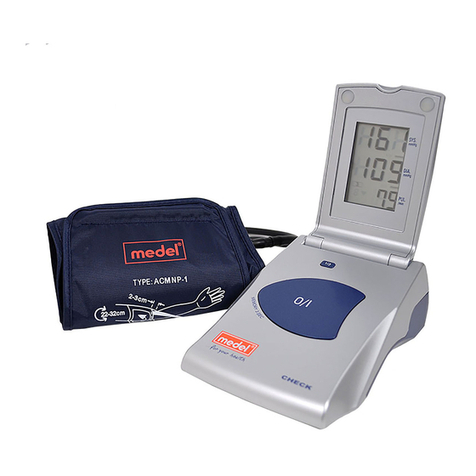
Medel
Medel Check User manual
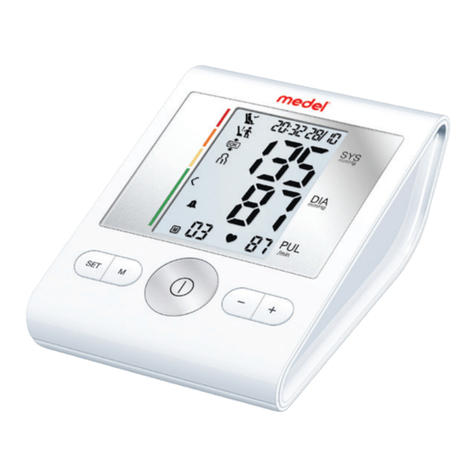
Medel
Medel GCE602 User manual
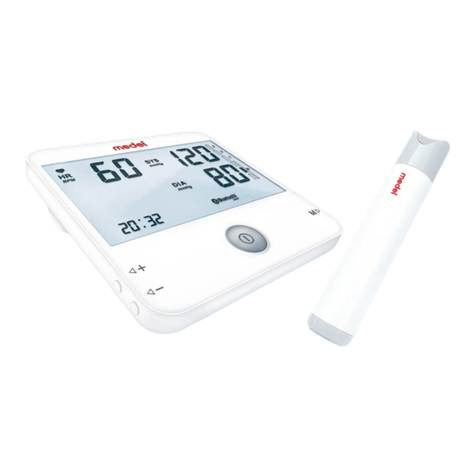
Medel
Medel Connect Cardio MB10 User manual

Medel
Medel Elite User manual
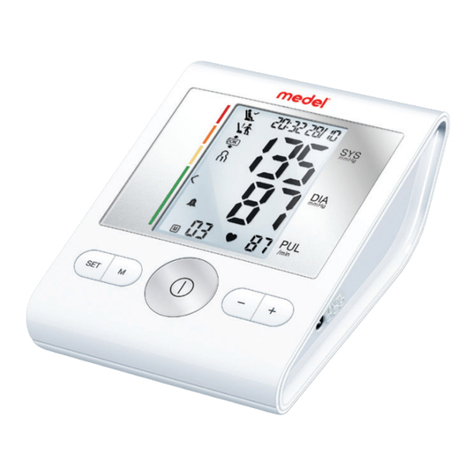
Medel
Medel GCE602 User manual
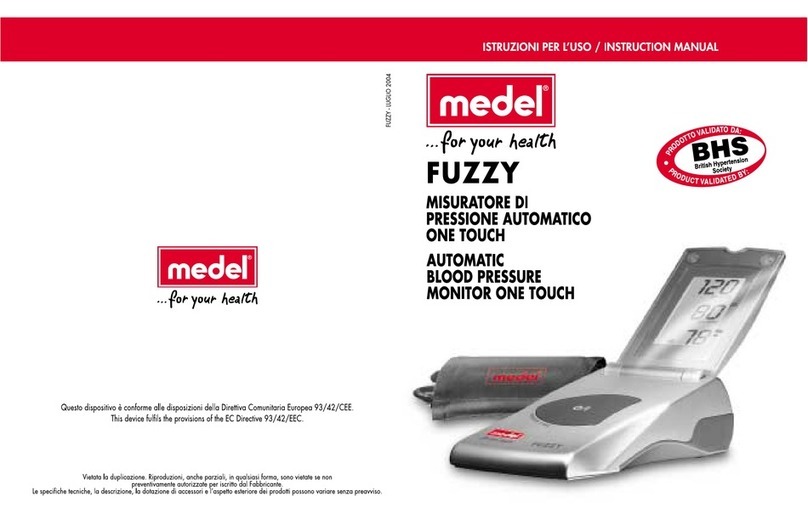
Medel
Medel FUZZY User manual
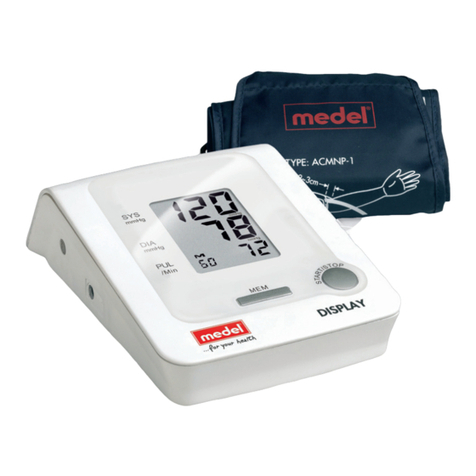
Medel
Medel ACMNP-1 User manual
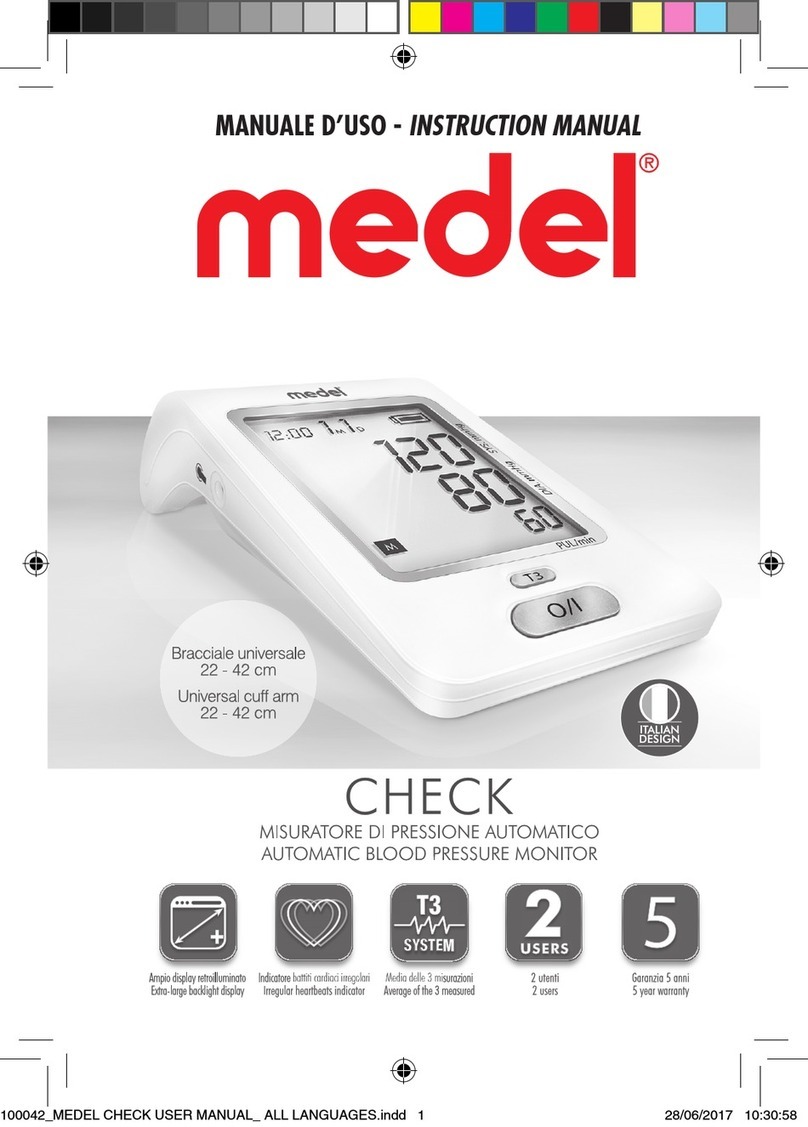
Medel
Medel Check User manual

Medel
Medel Elite User manual
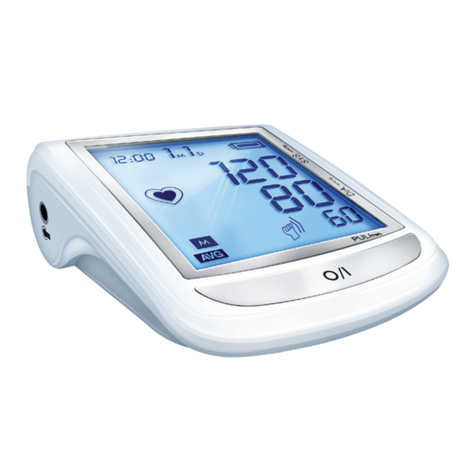
Medel
Medel ELITE 16897423 User manual


